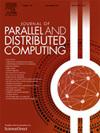Dispersion of mobile robots on directed anonymous graphs
IF 3.4
3区 计算机科学
Q1 COMPUTER SCIENCE, THEORY & METHODS
引用次数: 0
Abstract
Given any arbitrary initial configuration of robots positioned on the nodes of an n-node anonymous graph, the problem of dispersion is to autonomously reposition the robots such that each node will contain at most one robot. This problem gained significant interest due to its resemblance with several fundamental problems such as exploration, scattering, load balancing, relocation of electric cars to charging stations, etc. The objective is to solve dispersion simultaneously minimizing (or providing trade-off between) time and memory requirement at each robot. The literature mainly dealt with dispersion on undirected anonymous graphs. In this paper, we initiate the study of dispersion on directed anonymous graphs. We first show that it may not always be possible to solve dispersion when the directed graph is not strongly connected. We then establish some lower bounds on both time and memory requirement at each robot for solving dispersion on a strongly connected directed graph. Finally, we provide three deterministic algorithms solving dispersion on any strongly connected directed graph. Let D be the graph diameter, be its maximum out-degree, and d be the deficiency (the minimum number of edges needed to add to the graph to make it Eulerian). The first algorithm solves dispersion in time with bits at each robot. The second algorithm solves dispersion in time with bits at each robot. The third algorithm solves dispersion in time with bits at each robot, provided that robots in the 1-hop neighborhood can communicate. All three algorithms extend to handle crash faults.
移动机器人在有向匿名图上的离散性
给定任意k≤n个机器人的初始配置,放置在n节点匿名图的节点上,分散问题是自动重新定位机器人,使每个节点最多包含一个机器人。由于该问题与几个基本问题(如勘探、分散、负载平衡、电动汽车向充电站的迁移等)相似,因此引起了人们的极大兴趣。目标是同时解决分散问题,使每个机器人的时间和内存需求最小化(或在两者之间提供权衡)。文献主要研究无向匿名图上的色散问题。本文研究了有向匿名图上的色散问题。我们首先证明,当有向图不是强连接时,可能并不总是可以求解色散。然后,我们建立了求解强连通有向图上色散的时间和内存需求的下界。最后,我们给出了求解任意强连通有向图上色散的三种确定性算法。设D为图的直径,Δout为图的最大出度,D为缺边数(使图成为欧拉图所需的最小边数)。第一种算法在O(d⋅k2)时间内用O(k⋅log (k+Δout))位在每个机器人上解决色散问题。第二种算法在O(k2⋅Δout)时间内用O(log (k+Δout))位在每个机器人上解决色散问题。第三种算法在O(k⋅D)时间内用O(k⋅log (k+Δout))位解决每个机器人的色散问题,前提是1跳邻域内的机器人可以通信。这三种算法都扩展到处理崩溃故障。
本文章由计算机程序翻译,如有差异,请以英文原文为准。
求助全文
约1分钟内获得全文
求助全文
来源期刊

Journal of Parallel and Distributed Computing
工程技术-计算机:理论方法
CiteScore
10.30
自引率
2.60%
发文量
172
审稿时长
12 months
期刊介绍:
This international journal is directed to researchers, engineers, educators, managers, programmers, and users of computers who have particular interests in parallel processing and/or distributed computing.
The Journal of Parallel and Distributed Computing publishes original research papers and timely review articles on the theory, design, evaluation, and use of parallel and/or distributed computing systems. The journal also features special issues on these topics; again covering the full range from the design to the use of our targeted systems.
 求助内容:
求助内容: 应助结果提醒方式:
应助结果提醒方式:


